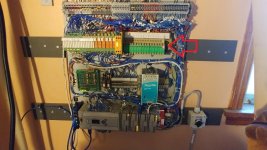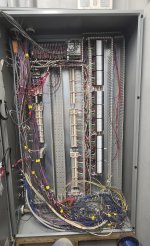AutomationTechBrian
Lifetime Supporting Member
I'd like to talk this through a little:
Relays are regularly used for PLC outputs, regardless of a need for signal conversion. But what about 24vdc input signals? Most of my experience has no signal isolation for 24v discrete input signals into PLC cards.
I'm in a conversation with a application engineer. My customer is replacing a panel. The integrators replacing the panel thought the discrete input signals were using 120vac, so they sent a panel with 120vac relays to convert the input signals for the 24vdc PLC input card. The input signals are not 120vac, they're 24v. And this is a replacement of a legacy panel, with the 24v input signals previously coming straight into the PLC (no relay).
In switching out the 120vac relays, I didn't think twice about not using a relay for 24v input signal isolation. In my eyes, the input card doesn't "pull" amps, and the relays become another point of failure. But the engineer is casting doubt on my decision with admonishments that they would not be held responsible for burnt-out inputs. I don't come across many burnt-out inputs... none that I can remember. What is your take on this issue? Do you use relays on input cards?
Relays are regularly used for PLC outputs, regardless of a need for signal conversion. But what about 24vdc input signals? Most of my experience has no signal isolation for 24v discrete input signals into PLC cards.
I'm in a conversation with a application engineer. My customer is replacing a panel. The integrators replacing the panel thought the discrete input signals were using 120vac, so they sent a panel with 120vac relays to convert the input signals for the 24vdc PLC input card. The input signals are not 120vac, they're 24v. And this is a replacement of a legacy panel, with the 24v input signals previously coming straight into the PLC (no relay).
In switching out the 120vac relays, I didn't think twice about not using a relay for 24v input signal isolation. In my eyes, the input card doesn't "pull" amps, and the relays become another point of failure. But the engineer is casting doubt on my decision with admonishments that they would not be held responsible for burnt-out inputs. I don't come across many burnt-out inputs... none that I can remember. What is your take on this issue? Do you use relays on input cards?







